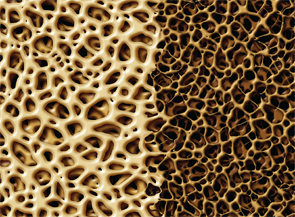
Bone with osteoporosis: Strong, healthy, normal spongy tissue (left) contrasted with unhealthy, porous weak structure due to aging or illness.
Lightspring/shutterstock.com
SAN FRANCISCO—The discovery of a promising new target for the treatment of osteoporosis has a beginning to the story that, when it comes to scientific breakthroughs, rings familiar: It started with a disappointment.
Researchers in the lab of Laurie H. Glimcher, MD, the Stephen and Suzanne Weiss Dean of Weill Cornell Medical College—were in search of a transcription factor that controls differentiation of type-1 T-lymphocytes, and turned to Schnurri-3, part of a small family of very large proteins that has been highly conserved through evolution. Schnurri-3, they found, didn’t do that.
But Dr. Glimcher figured that it had to do something—it had to have some phenotype in the immune system, given that so many effects on immune cells had been seen ex vivo. Then she learned that her lab had not yet looked at bone marrow.
When they looked at X-rays of mice in whom Schnurri-3 had been knocked out, they were startled: “The animals had massively increased bone mass,” Dr. Glimcher recalled, in her Oscar S. Gluck, MD, Memorial Lecture, given at the 2015 ACR/ARHP Annual Meeting.
As they continued to examine the gene and its mechanisms, they realized that it might be the key to a new treatment approach in osteoporosis, which affects more than 200 million people worldwide, with one in three women and one in five men suffering an osteoporosis-related fracture in their lifetime.
Osteoporosis is the world’s most common disease—more prevalent than cancer or heart disease, Dr. Glimcher noted. But therapies have been hampered because those that promote bone growth also, eventually, promote bone decay and vice versa.
New therapies are under investigation that would buck this trend, such as the cathepsin K-inhibitor odanacatib and the sclerostin antibody CDP7851.
In a particularly exciting discovery, researchers found that knocking out Schnurri-3 resulted in a kind of decoupling of bone resorption & formation.
Dr. Glimcher said that therapies targeting Schnurri-3 also hold much promise. Once the attention of her lab turned to Schnurri-3’s role in bone growth, they looked into how loss of the gene affects age-associated bone loss. In Schnurri-3 knockout mice they found that bone continued to accumulate from baseline at six weeks through 18 months.1
Moreover, Dr. Glimcher said, “there is no apparent secondary pathology that one needs to worry about. The bone that’s formed by biophysical analysis is lamellar bone. It has increased strength.” There was also no ectopic mineralization and no instance of osteosarcomas seen—and they’ve been observing the mice for more than 12 years.
They later found that the Schnurri-3 gene product is required in osteoblasts—when selectively deleted in osteoblasts, you can recreate the phenotype—and that it seemed to be active at every stage of differentiation.
In a particularly exciting discovery, researchers found that knocking out Schnurri-3 resulted in a kind of decoupling of bone resorption and formation, running counter to the “dogma” that resorption and formation always go hand in hand.2
“We see very high bone formation in Schnurri-3 knockout animals, but we actually see reduced rates of bone resorption,” Dr. Glimcher said. Schnurri-3’s role in inhibiting bone resorption is related to its role in promoting RANK-ligand activity, she said.
“It turns out that Schnurri-3 is a co-activator of the key transcription factor called CREB that activates transcription of the RANK ligand gene,” she said. “Hence, in the absence of Schnurri-3, CREB is much less potent and you get lower levels of RANK ligand,” she said. “So that was a molecular answer to the question of how Schnurri-3 inhibits osteoclast activation.
“It is a fortunate event since we now have a gene whose silencing would result in both an increase in bone formation and at the same time inhibit bone resorption,” Dr. Glimcher said.
Researchers tested this further by inducing muscle paralysis in Schnurri-3 knockout mice, which would typically cause bone loss due to atrophy in normal mice. But in these mice, there was not only no bone loss, but bone continued to accumulate.
They then delved into the mechanisms and came away with these findings:
- Most of the activity of Schnurri-3 could be traced back to just a small portion of the molecule—to just three amino acids that sit within the D-domain, a binding site for a protein in the MAP kinase pathway, which controls bone mass.
- Within the D domain, Schnurri-3 represses the activity of ERK, extracellular-signal-regulated kinase, which leads to low bone mass.
- There is genetic interaction between Schnurri-3 and LRP5, a receptor that is mutated in some patients, causing low bone mass.
Dr. Glimcher acknowledged that predicting the effect of a therapy that reduces the activity of a gene vs. complete deletion of that gene can be tricky: “It is different than treating a patient with a drug, because when you’re treating a patient with a drug you’re not completely deleting that target from Day 0.” So they transiently inhibited Schnurri-3 in adult mice for six weeks and found that the levels were reduced by about 35%, and found that that was enough to have a positive impact on bone mass.
Now, in conjunction with a pharmaceutical company, her lab is in search of small molecules that inhibit the activity of Schnurri-3 to prevent its bone-mass-reducing effects. Using specially designed assays, they hope to find several such molecules.
“Within a few months,” she said, there will hopefully be “more to say about what some of those molecules might be.”
Thomas R. Collins is a medical writer based in Florida.
References
- Jones DC, Wein MN, Oukka M, et al. Regulation of adult bone mass by the zinc finger adapter protein Schnurri-3. Science. 2006 May 26;312(5777):1223–1227.
- Wein MN, Jones DC, Shim JH, et al. Control of bone resorption in mice by Schnurri-3. Proc Natl Acad Sci U S A. 2012 May 22;109(21):8173–8178.
